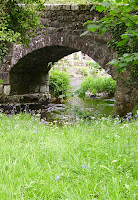Castle Drogo and the Teign valley
On a brighter and much sunnier day we visited the opposite side of the moor that is closer to Drewsteignton. Off on one of our exploration days we headed towards the edge of the national park that lies at the foot of the moorlands.
Castle Drogo was built in the 1910s and 1920s for Julius Drew ( founder of home and colonial stores) and was designed by Edwin Luytins. It was the last castle to be built in England, and probably the last private house in the country to be built entirely of granite. It's in the style of the medieval and Tudor periods.
The castle h
 as a lovely garden, which contrasts effectively with its striking setting on the edge of Dartmoor. The garden is noted for its rhododendrons and magnolias and herbaceous borders.
as a lovely garden, which contrasts effectively with its striking setting on the edge of Dartmoor. The garden is noted for its rhododendrons and magnolias and herbaceous borders.Luckily we had Oli's media pass else I don't think we would have paid the hefty entrance fee to have a look around.
 However for me the idea was to pick up 'hunter's path' and head off into the Teign Valley and Fingle bridge! From rocky outcrops we could look out towards Dartmoor and down towards the river below. We cou
However for me the idea was to pick up 'hunter's path' and head off into the Teign Valley and Fingle bridge! From rocky outcrops we could look out towards Dartmoor and down towards the river below. We cou ldn't see it but it could be heard meandering somewhere below amongst the trees. The path descends steeply to the bottom of the valley where you reach Fingle Bridge.
ldn't see it but it could be heard meandering somewhere below amongst the trees. The path descends steeply to the bottom of the valley where you reach Fingle Bridge.


Fingle Bridge, its very name sounds like something straight from the pages of a fairy tale, bringing images of piskies and woodland spirits to mind! The name Fingle is the name of a stream that rises on Wh

This part of the river is well known for its Otter population and I kept my beady eyes searching the river banks as we began our return along the valley floor. You can also see dragonflies and kingfishers and the river is full of fish including Salmon. Not an Otter in sight but it was very pretty! The water runs dark and colorful over the rocks and lichens hang like veils from the branches of the trees. Several countrymen were fly fishing, very relaxing to watch! The light filtered through the new leaves and reflections glistened in the water highlighting all the newly hatched midges that danced above the water! This was a great spot for a picnic or a lazy walk wildlife spotting.
Here is a poem by the famous poet Keats who loved to stay in the region that inspired so many of this poems.
Keats' poem
Here all the summer could I stay
For there's Bishop's teign
And King's teign
And Coomb at the clear Teign head -
Where close by the stream
You may have your cream
All spread upon barley bread.
There's arch Brook
And there's larch Brook
Both turning many a mill;
And cooling the drouth
Of the salmon's mouth,
And fattening his silver gill.
There is Wild wood,
A Mild hood
To the sheep on the lea o' the down,
Where the golden furze,
With its green, thin spurs,
Doth catch at the maiden's gown.
There is Newton Marsh
With its spear grass harsh -
A pleasant summer level
Where the maidens sweet
Of the Market Street,
Do meet in the dusk to revel.
There's the Barton rich
With dyke and ditch
And hedge for the thrush to live in
And the hollow tree
For the buzzing bee
And a bank for the wasp to hive in.
And O, and O
The daisies blow
And the primroses are waken'd,
And violets white
Sit in silver plight,
And the green bud's as long as the spike end.
Then who would go
Into dark Soho,
And chatter with dack'd-hair'd critics,
When he can stay
For the new-mown hay,
And startle the
dappled prickets?







0 Comments:
Post a Comment
<< Home